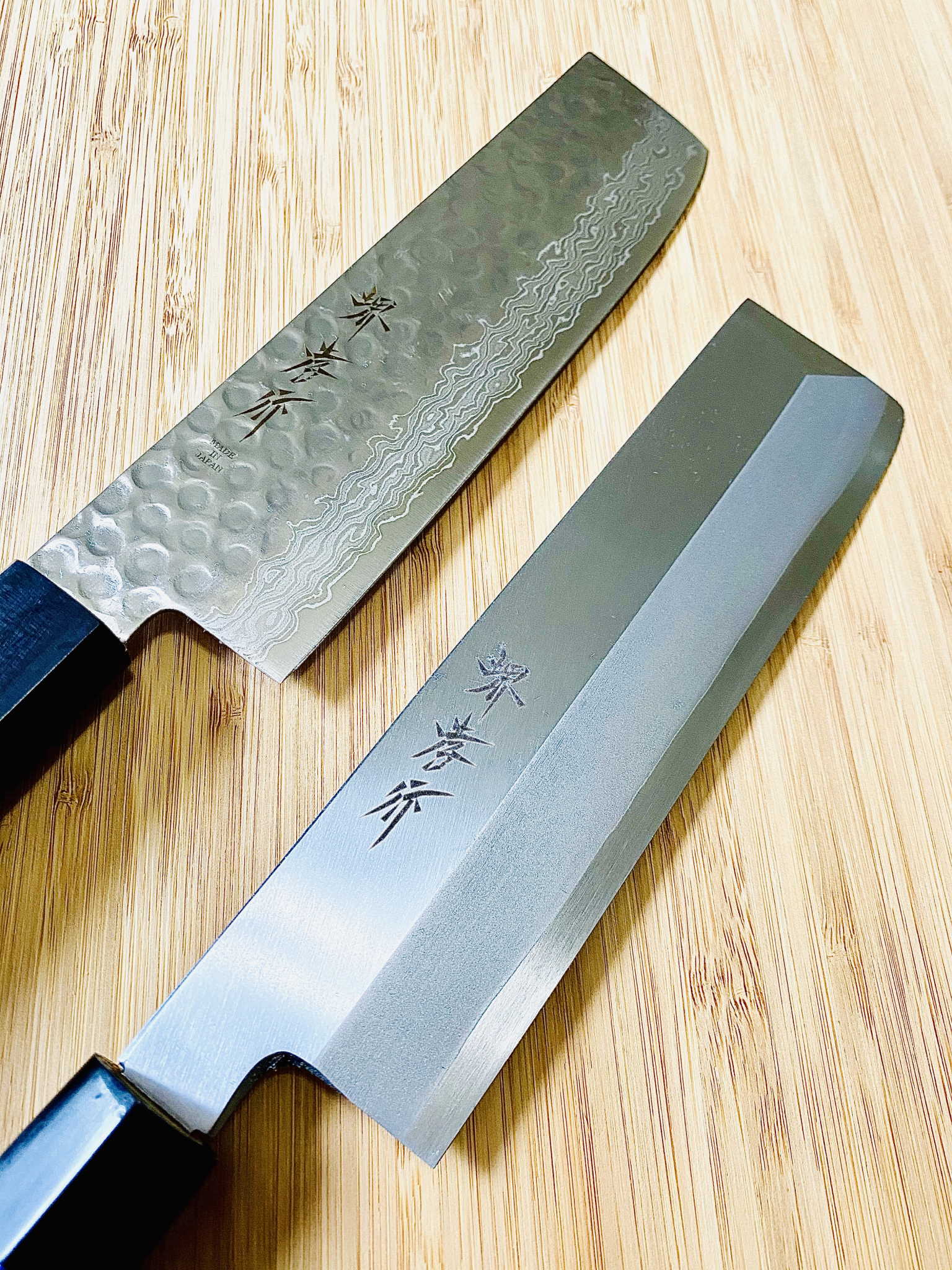A single bevel knife may be the better choice if you’re looking for a specialized tool for a specific task, while a double bevel knife is probably a better option if you need a versatile, all-purpose knife. Single bevel knives are favored in specific types of cooking, such as Japanese cuisine, as they offer a key advantage – they are extremely sharp.
This is due to the fact that they only need to be honed on one side, making it easier to create a much smaller, and therefore sharper, angle. On the other hand, double bevel knives have angled surfaces on both sides, providing balance and precision for various cutting tasks.
Overall, the choice between single bevel and double bevel knives depends on your specific needs and preferences.

Credit: prudentreviews.com
Single Bevel Knife: Precision And Specialization
What is a single bevel knife?
A single bevel knife is a type of blade that has only one angled surface or bevel. Unlike double bevel knives, which have angled surfaces on both sides of the blade, single bevel knives have a flat side on one of the edges. This unique characteristic gives single bevel knives their precision and specialization, making them ideal for specific tasks and culinary techniques.
The unique characteristics of a single bevel knife
The single bevel knife stands apart from its double bevel counterparts due to its distinct features. Some of the unique characteristics of a single bevel knife include:
Sharpness: Single bevel knives are known for their exceptional sharpness. Since they only have one beveled edge that requires honing, it is easier to achieve a smaller, sharper angle. This sharpness translates into precise cuts, intricate designs, and excellent control.
Pecialization: Single bevel knives are highly specialized tools, often used in Japanese cuisine. They are designed for specific culinary techniques such as sushi preparation, vegetable garnishing, and precision cuts. The single bevel allows for more controlled movements and improved accuracy.
Balance: Due to the single bevel construction, these knives offer a unique balance. The flat side of the blade provides stability, while the beveled side allows for easy slicing and precise cutting.
Advantages of using a single bevel knife
There are several advantages to using a single bevel knife, including:
Precision: The single bevel’s sharpness and specialized design make it an excellent tool for tasks that require precision and intricate cuts. Whether you’re slicing sushi or creating decorative vegetable designs, a single bevel knife allows for greater accuracy.
Control: Single bevel knives offer enhanced control due to their unique balance and specialized construction. With proper technique and skill, you can achieve more controlled and accurate cuts.
Versatility within specialization: Although single bevel knives are highly specialized, they still offer versatility within their intended use. For example, a sushi knife can also be used for delicate filleting tasks or slicing other ingredients with precision.
Applications and best use cases for single bevel knives
Single bevel knives excel in various culinary techniques and applications. Some of the best use cases for single bevel knives include:
Sushi preparation: Single bevel sushi knives, also known as Yanagiba or Sashimi knives, are specifically designed for cutting thin slices of fish and creating elegant sushi presentations. The single bevel allows for clean, precise cuts without tearing the delicate fish.
Vegetable carving and garnishing: Single bevel knives, such as the Usuba or Nakiri knives, are popular among chefs for vegetable carving and garnishing. The sharp, single bevel allows for detailed designs and intricate cuts on vegetables, resulting in visually stunning dishes.
Precision cutting: Single bevel knives are excellent for precision cutting tasks that require accuracy and control. Whether it’s trimming meat, removing bones, or creating precise slices, the single bevel design ensures clean and precise results.
single bevel knives offer precision and specialization in the culinary world. Their unique characteristics, advantages, and best use cases make them essential tools for chefs and enthusiasts who value accuracy and control in their knife work.
Double Bevel Knife: Versatility And Practicality
What is a double bevel knife?
A double bevel knife, also known as a double-edged knife, is a versatile and practical tool used in various culinary applications. Unlike a single bevel knife that has only one angled surface, a double bevel knife has two angled surfaces on its blade. These angles are symmetrically placed on either side of the blade, creating a V-shaped edge. This unique design allows for enhanced precision, control, and efficiency during cutting, slicing, and chopping tasks.
The distinct features of a double bevel knife
Double bevel knives are easily distinguished by their symmetrical design and V-shaped edge. Here are the distinctive features of a double bevel knife:
1. V-shaped edge: The double bevel knife’s blade features a sharp V-shaped edge that ensures clean and precise cuts.
2. Symmetric angles: The angles on both sides of the blade are precisely equal, creating a balanced and symmetrical cutting edge.
3. Two cutting surfaces: With two beveled surfaces, a double bevel knife can be used comfortably by both right-handed and left-handed individuals.
4. Enhanced stability: The symmetrical design of a double bevel knife provides improved stability and control during cutting, making it ideal for intricate tasks.
Benefits of using a double bevel knife
Using a double bevel knife offers several benefits for both professional chefs and home cooks. Here are some of the advantages:
1. Versatility: Double bevel knives are highly versatile and can be used for various cutting techniques, including slicing, chopping, and dicing. From delicate vegetables to robust meats, a double bevel knife can handle it all.
2. Precision: The symmetrical edges of a double bevel knife allow for precise and controlled cuts, making it an essential tool for tasks that require accuracy, such as filleting fish or slicing sushi.
3. Efficiency: The V-shaped edge of a double bevel knife enhances cutting efficiency, reducing the effort needed to slice through ingredients. This efficiency is particularly useful for tasks that require repetitive cutting motions.
4. Comfort: Double bevel knives are designed to provide ergonomic comfort during use. The balanced weight distribution and symmetrical angles make them easy to handle and maneuver for extended periods.
Common uses and versatility of double bevel knives
Thanks to their versatility, double bevel knives have a wide range of uses in the kitchen. Here are some common applications where double bevel knives excel:
1. General food preparation: From chopping vegetables and mincing herbs to trimming meat and deboning poultry, a double bevel knife is an excellent all-purpose tool for everyday food preparation tasks.
2. Slicing and filleting: The precise control and sharp edge of a double bevel knife make it ideal for slicing thin cuts of meat, filleting fish, or creating paper-thin slices of fruits and vegetables.
3. Precision cutting: Double bevel knives are often favored by professional chefs for intricate cutting techniques, such as julienning, chiffonade, and brunoise. The symmetrical edge allows for precise and consistent results.
4. Crafting elaborate garnishes: Double bevel knives are commonly used to create decorative garnishes, such as vegetable flowers, citrus twists, and intricate fruit carvings. Their precise cutting abilities make them a must-have for culinary artistry.
In conclusion, the double bevel knife’s versatility and practicality make it an essential tool in any kitchen. Its unique features, such as the V-shaped edge, symmetrical angles, and enhanced stability, provide the user with precision, control, efficiency, and comfort. Whether you are a seasoned chef or a passionate home cook, a double bevel knife is an excellent addition to your culinary arsenal.
Choosing The Right Knife: Factors To Consider
When it comes to choosing the right knife, there are several factors you need to consider. One of the most important is whether to go for a single bevel or double bevel knife. Understanding the differences and advantages of each type can help you make an informed decision. In this article, we will discuss the factors and considerations you should keep in mind when choosing between a single bevel and double bevel knife.
Understanding your specific needs and preferences
Before diving into the comparison, it is essential to understand your specific needs and preferences. Consider the type of cooking you do, the ingredients you work with, and the tasks you frequently perform in the kitchen. Are you looking for a specialized tool for a specific task or a versatile, all-purpose knife?
Comparing the advantages and disadvantages of single bevel and double bevel knives
Let’s compare the advantages and disadvantages of single bevel and double bevel knives:
Single Bevel Knives
- Extremely sharp due to honing on only one side.
- Allows for creating smaller, sharper angles for precise cuts.
- Preferred in specific types of cooking, such as Japanese cuisine.
- Specialized for tasks like sushi preparation or delicate slicing.
- May be harder to sharpen correctly due to the single bevel.
Double Bevel Knives
- Offers versatility and can be used for a wide range of tasks.
- Provides a balanced cutting experience for both left and right-handed users.
- Easier to sharpen due to the bevels on both sides.
- Not as sharp as single bevel knives but still efficient for most kitchen tasks.
- Suitable for general kitchen use and everyday cooking needs.
Evaluating the level of skill and experience required for each type of knife
It’s important to consider your level of skill and experience when choosing between a single bevel and double bevel knife. Single bevel knives require more precision and technique, making them better suited for experienced cooks who have mastered the art of knife handling. On the other hand, double bevel knives are more forgiving and easier to handle, making them suitable for cooks of all skill levels.
Considering the maintenance and sharpening requirements for different knife types
Another crucial factor to consider is the maintenance and sharpening requirements for different knife types. Single bevel knives can be more challenging to sharpen correctly due to their unique design. You may need to send them to a professional sharpener or invest in specialized sharpening tools. Double bevel knives, on the other hand, can be sharpened using more common sharpening methods and tools, making them easier to maintain.
When choosing between a single bevel and double bevel knife, it’s essential to weigh the advantages and disadvantages, consider your specific needs and preferences, evaluate your skill level, and factor in the maintenance and sharpening requirements. Ultimately, the right knife for you will depend on your individual cooking style and the tasks you perform in the kitchen.
Conclusion
When it comes to choosing between a single bevel and double bevel knife, it ultimately depends on your specific needs and preferences. A single bevel knife is favored in certain types of cooking, such as Japanese cuisine, because it offers a key advantage – extreme sharpness.
Due to the fact that it only needs to be honed on one side, a much smaller and sharper angle can be achieved. On the other hand, a double bevel knife is a more versatile and all-purpose option. It is sharpened on both sides, providing balance and stability while cutting.
Both types of knives have their own advantages and considerations, so it’s important to evaluate what tasks you will be using the knife for and choose accordingly. Whichever you choose, make sure to select a high-quality knife that suits your needs and enhances your culinary experience.

This is Kristina, a passionate content writer, copywriter, and bookworm. Always dedicated to providing informative and accurate product reviews for enjoyable shopping. In my free time, I love spending time in nature and with animals and doing yoga.

